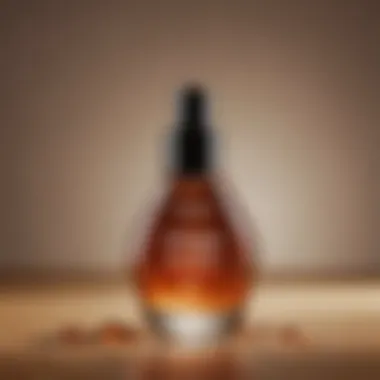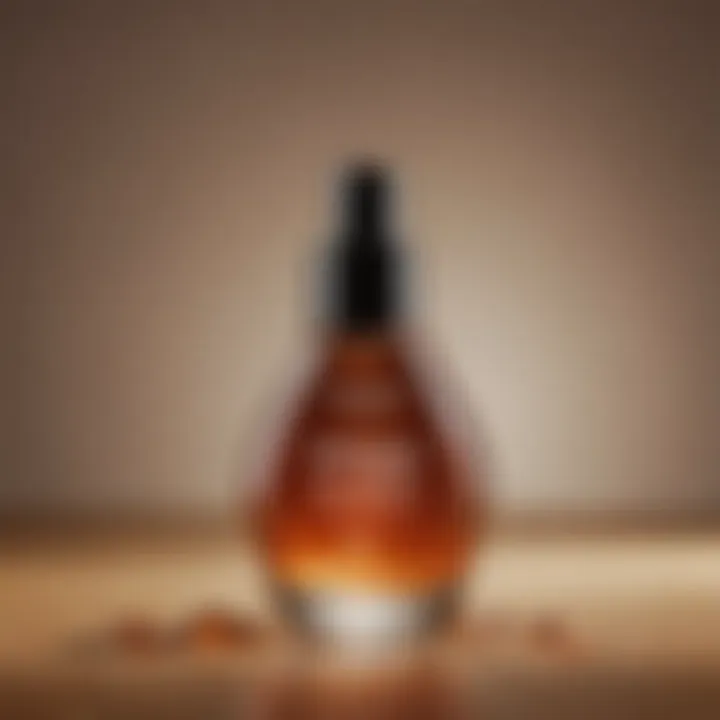Top Tanning Drops for Fair Skin: A Comprehensive Guide


Intro
Pale skin has its own charm, yet it often comes with challenges when it comes to achieving a sun-kissed glow. Tanning drops offer a solution for those who wish to enhance their skin tone without exposing themselves to harmful UV rays. This guide will navigate through the best tanning drops available for pale skin, elucidating their effectiveness, how to apply them correctly, and what ingredients to prioritize for safety.
Understanding how tanning drops work is fundamental. These products contain active ingredients like dihydroxyacetone (DHA), which reacts with the amino acids in the skin's surface to produce a darker hue. This is significant for people with pale skin, as improper application can lead to undesirable results such as streaks or an orange tint. Hence, it is crucial to choose the right product and follow the appropriate techniques.
In the following sections, we will cover various aspects of tanning drops, from current beauty trends to practical tips for application. Additionally, we will review top products, comparing their features to assist in making informed choices. By synthesizing all this information, our aim is to empower readers to achieve a natural-looking tan safely and confidently.
"With a plethora of tanning options, making the right choice can feel overwhelming, especially for pale skin. This guide is tailored to clarify that process."
Fashion Trends
Seasonal Styles
As pale skin becomes a canvas for various trends, understanding seasonal styles can help in selecting the perfect times to use tanning drops. Spring and summer often call for lighter tones and a radiant look, making tanning drops highly sought after. During these seasons, many people opt for a subtle glow to complement brighter clothing and outdoor activities.
Influencer Inspirations
Social media plays a decisive role in influencing beauty trends. Influencers frequently share their tanning routines, showcasing the transformative power of tanning drops. Most emphasize the importance of even application and proper blending to secure a natural finish. Following these trends can inspire users to experiment with colors and styles, tailored to highlight their unique skin tones.
Beauty Tips
Skincare Routines
Skin preparation is pivotal for the effective application of tanning drops. Following a diligent skincare routine can ensure better results. Here are some basic steps to adopt:
- Exfoliate the skin 24 hours before application to remove dead skin cells.
- Moisturize dry areas like elbows and knees where the color may deepen unevenly.
- Clean the skin properly to eliminate any residue from previous products.
Makeup Techniques
Integrating makeup with tanning drops enhances the overall look. Light foundation or BB cream can balance the tan, while bronzer can effectively accentuate features. Choose shades that complement your newly acquired tan without overpowering the skin's natural tone.
Product Reviews
Trending Products
- L'Oreal Paris Sublime Bronze Self-Tanning Drops: These drops are known for their lightweight formula and customizable shade. They are easy to mix with other skincare products, ensuring an even application.
- St. Tropez Luxe Whipped Crème Tanning Mousse: Designed to provide an instant glow, this product is suitable for pale skin and works quickly without streaking.
Comparison Guides
When choosing between products, consider the following:
- Active ingredients: Look for DHA percentage and any added botanicals that aid in skin nourishment.
- Color development time: Some products take longer than others; understanding this will help in planning application.
- User reviews: Feedback from others with pale skin can shed light on the product's effectiveness and any challenges faced.
By thoroughly reviewing these aspects, users can find tanning drops that align with their needs and preferences, resulting in a natural, radiant glow.
Intro to Tanning Drops
Tanning drops have become a popular choice for those seeking a sun-kissed appearance without the exposure to harmful UV rays. This article aims to explore various facets of tanning drops, especially for individuals with pale skin, offering a clear path to achieving a natural-looking glow.
Definition and Purpose
Tanning drops are liquid products that typically contain dihydroxyacetone (DHA), the active ingredient that reacts with the skin's amino acids to create a bronzed effect. These drops are versatile and can be mixed with moisturizers or serums for customized application. The main purpose of tanning drops is to provide a safe alternative to traditional tanning methods, such as sunbathing or tanning beds, which can lead to skin damage over time. For those with fair complexion, tanning drops can enhance their skin tone while also minimizing the risk of sunburn or skin cancer.
Why Choose Tanning Drops Over Other Methods
Choosing tanning drops offers several advantages over older tanning methods:
- Customization: Users can control how dark their tan gets by adjusting the amount of product used.
- Reduced Risk: Unlike tanning beds, these drops do not expose the skin to UVA and UVB rays, lowering the risk of skin cancer.
- Convenience: Tanning drops can be applied at home, saving both time and money spent on salon sessions or trips to the beach.
- Less Maintenance: The longevity of a tan obtained through tanning drops means less frequent touch-ups, streamlining the process.
"Tanning drops empower individuals to achieve a glow that suits their skin type and personal preferences while avoiding harmful sun exposure."
Overall, the effective use of tanning drops can lead to a satisfying and safer way to achieve a desired complexion, especially for those who may struggle with traditional tanning methods.


Understanding Pale Skin
Understanding pale skin is essential in the context of choosing the right tanning drops. Many people with pale skin are sensitive to sun exposure, making them more prone to sunburns, skin damage, and uneven tanning. This section provides insights into the characteristics that define pale skin and the common challenges these individuals face.
Characteristics of Pale Skin
Pale skin is often described as fair or light-toned. It frequently lacks melanin, which is the pigment responsible for skin color. Here are some important characteristics:
- Subtypes: Pale skin can vary in subtypes, including porcelain, ivory, and lightly freckled. Each type exhibits its own unique undertones, ranging from cool pinks to warm golden hues.
- Tendency to Burn: Individuals with pale skin typically burn rather than tan when exposed to UV rays. This undesirable outcome leads many to seek alternative methods for achieving a tanned look.
- Sensitivity: The skin is usually more sensitive to chemicals and environmental factors. Therefore, the selection of products must be done carefully to avoid irritation.
- Vein Visibility: In many cases, veins may appear more prominent under the skin, often taking on a bluish tint. This characteristic can indicate thin epidermis layers common with pale skin.
Common Challenges Faced
Those with pale skin often encounter specific challenges when seeking a tan. Some of these challenges include:
- Streaking and Unevenness: Many tanning products can lead to streaks or patchiness if not applied properly. This is particularly concerning for those with fair skin, where imperfections are more noticeable.
- Orange Undertones: A common fear among users is the appearance of an unnatural orange tint after using tanning drops. Selecting high-quality products becomes crucial for avoiding this issue.
- Limited Sun Exposure: Due to their skin's reaction to sunlight, many individuals avoid prolonged sun exposure. This leads to a lack of a natural tan, prompting the search for alternatives like tanning drops.
- Skin Conditions: Pale skin is often more vulnerable to conditions like eczema or rosacea. As such, individuals need to be cautious about the ingredients in tanning products.
Mechanism of Tanning Drops
Understanding the mechanism of tanning drops is essential for anyone looking to achieve a beautiful, natural-looking tan, especially for those with pale skin. This section examines how tanning drops work, delving into their chemical composition and their interaction with skin to produce results.
Chemical Components and Their Functions
Tanning drops primarily rely on a key ingredient known as dihydroxyacetone (DHA). DHA is a colorless sugar that interacts with the amino acids in the outermost layer of skin. When applied, it initiates a chemical reaction that produces a bronze pigment. This pigmentation process typically takes a few hours and can last up to a week, depending on skin type and the formulation of the tanning drops used.
Additionally, many tanning drops contain other beneficial ingredients like erythrulose, which can enhance and prolong the tan. Erythrulose works similarly to DHA but may provide a more even and natural finish on certain skin tones. Other common ingredients include moisturizing agents such as glycerin and hyaluronic acid. These components help keep the skin hydrated, which is crucial for maintaining a smooth appearance throughout the tanning process.
How Tanning Drops Interact with Skin
Tanning drops interact with the skin in a few notable ways. First, they require preparation of the skin surface for optimal results. Exfoliating the skin before application is beneficial, as it removes dead skin cells and allows for an even absorption of the product.
Once applied, the active ingredients penetrate the skin. The resulting chemical reaction with the proteins present in the skin surface leads to the coloration over time. The interaction of DHA or erythrulose with the skin does not provide UV protection. Thus, while tanning drops can enhance your skin tone, users must continue to apply sunscreen when exposed to sunlight.
Maintaining a proper routine post-application is also important. Moisturizers can help extend the life of the tan by keeping the skin from peeling or oxidizing too quickly. Moreover, user technique during application is vital; uneven application can lead to streaks or patchiness. Following the guide in this article will ensure a more natural finish without undesired orange tones.
"It’s not just about achieving a tan; it’s about how you manage the process to ensure it lasts beautifully."
In summary, understanding the mechanism of tanning drops allows users, especially those with pale skin, to make informed choices about product selection and application techniques. By knowing how the ingredients work and interact with the skin, users can optimize their tanning results.
Factors to Consider When Choosing Tanning Drops
Choosing the right tanning drops is essential for individuals with pale skin. The wrong product can lead to undesired results such as an unnatural color, streaks, or an uneven application. Therefore, evaluating certain factors can significantly enhance the effectiveness of these tools.
Skin Type Compatibility
Understanding skin type compatibility is crucial when selecting tanning drops. Skin types range from oily to dry, sensitive, or combination. Each type has distinct needs. For instance, those with dry skin should look for moisturizing ingredients that will enrich their skin while providing a bronzed effect. In contrast, individuals with oily skin might benefit from non-comedogenic formulas that will not clog their pores.
Furthermore, sensitive skin requires special attention. Products designed with gentle formulations tend to reduce the risk of irritation and allergic reactions. Always read labels carefully. Checking for dermatological tests or hypoallergenic claims can provide safety assurance.
Desired Tan Level
Determining the desired tan level is another key consideration. Tanning drops come in various strengths and formulations. Some are designed for a light glow, while others provide a more intense bronzed tan. For pale skin, opting for drops that offer a subtle enhancement can be wise. It is wise to start with a lower concentration until one can assess how skin reacts.
A gradual tan build-up allows for more control over the shade intensity. Therefore, check the product descriptions for details on the expected results and recommended application frequency.
Ingredients to Look For
Ingredients play a significant role in both the efficacy and safety of tanning drops. Pay attention to key components such as DHA, which is the primary active ingredient responsible for skin coloration. It causes a reaction with the amino acids in dead skin cells, giving a bronzed appearance. Look for products with added vitamins and natural oils that can hydrate and soothe the skin.
In addition, steer clear of harmful ingredients like parabens and synthetic fragrances, as they can irritate delicate skin. Opt for natural and organic options that are not only effective but also environmentally conscious. Reading customer reviews about ingredient performance and compatibility is advisable before making a choice.
"Considering skin compatibility, desired results, and ingredients can significantly increase satisfaction with tanning drops, especially for those with pale skin."
By taking these factors into account, individuals can make informed decisions that suit their needs, ensuring a healthy and natural-looking tan.
Application Techniques for Tanning Drops


When it comes to achieving a flawless tan, the application techniques used for tanning drops are paramount. Proper techniques can significantly affect the outcome of your tan, determining whether it appears natural or leaves an undesirable streaked effect. Understanding how to effectively apply tanning drops will ensure that you enhance your pale skin without the risk of orange or uneven hues. This section will cover the preparation of the skin, a step-by-step guide for application, and tips for ensuring even coverage.
Preparation of Skin Prior to Application
The state of your skin before applying tanning drops can influence how well the product adheres and develops. Here are essential steps for preparing your skin:
- Exfoliate: Use a gentle body scrub or exfoliating mitt in the days leading up to your application. This removes dead skin cells and allows for a smoother surface for the tanning drops. Focus particularly on areas that tend to be dry, such as elbows and knees.
- Moisturize: Apply a light moisturizer to your skin. This helps prevent the tanning drops from clinging to dry patches, which can cause uneven tan appearance. Avoid heavy creams that might interfere with absorption.
- Cleanse: Before application, make sure your skin is clean, and free of any lotions, oils, or perfumes. These can create barriers that affect how the tanning drops interact with your skin.
Step-by-Step Guide to Application
Following a precise application process can drastically improve the results of your tanning drops. Here’s a simple, effective guide:
- Shake the bottle: Always shake your tanning drop bottle well before use. This ensures an even distribution of ingredients.
- Use gloves: Wearing gloves can prevent stained hands. If you prefer bare hands, wash them immediately after applying.
- Apply drops: Start with a small amount of drops. Use one to three drops per area, such as your arms or legs, depending on how deep you want the tan to be.
- Blend well: Use your palms to spread the drops evenly across your skin. Circular motions help distribute the product uniformly. Pay careful attention to joints where product can accumulate.
- Dry time: Allow your skin to dry completely before getting dressed. This usually takes a few minutes but can vary based on product type.
Tips for Achieving Even Coverage
To ensure that your tan looks seamless and natural, keep these tips in mind:
- Start Light: Begin with fewer drops than you think you’ll need. You can always add more later to deepen the color.
- Layering: If you want a darker tan, consider applying a second layer after the first layer has completely dried. This helps build the tan gradually and avoid uneven patches.
- Check for mistakes: After application, inspect for spots that may appear darker. You can lightly buff these areas with a damp cloth to even out any discrepancies.
"Achieving an even tan requires attention to detail during application. Every step counts in the journey to a glowing complexion."
Following these techniques can significantly improve your experience and outcome with tanning drops. Proper application minimizes streaking, enhances tan longevity, and ultimately allows for a radiant finish.
Top Recommended Tanning Drops for Pale Skin
Finding the right tanning drops tailored for pale skin is crucial. These products promise to enhance your natural glow without the undesired effects that can occur from using tanning methods unsuitable for lighter skin tones. Choosing the right tanning drops can result in a natural-looking tan, which boosts confidence and provides an even complexion. Thus, identifying effective tanning drops should be based on ingredients, user experience, and brand reputation.
Review of Leading Brands
Several brands have established themselves as leaders in the market for tanning drops, especially for users with pale skin. A few standout products include:
- St. Tropez Luxe Whipped Crème Mousse: This product is known for its lightweight formula and is easy to apply, ensuring an even finish. Ideal for pale skin, it includes moisturizing elements.
- Isle of Paradise Self-Tanning Drops: These drops are formulated with color-correcting technology, making them excellent for reducing any unwanted undertones. They offer various shade options to cater to individual preferences.
- Tan-Luxe The Face Drops: A favorite among many, these drops are designed specifically for facial skin. They blend well with skincare products, ensuring a natural and radiant look.
- Bondi Sands Self Tanning Foam: While primarily a foam, Bondi Sands also offers drops suitable for pale skin, renowned for their quick-drying properties and easy application.
These brands are highly regarded due to their commitment to quality and customer satisfaction. They prioritize user experience and safety, key for individuals with pale skin who might be prone to reactions.
Comparison of Key Features and Benefits
When evaluating tanning drops, several features and benefits come into play, particularly when the skin's lightness is a factor. Here’s a detailed comparison of the essential aspects to consider:
- Ingredients: Look for natural components like dihydroxyacetone (DHA), which is the primary active ingredient in most tanning products. Tanning drops infused with aloe vera or vitamin E provide additional hydration.
- Ease of Use: Products that are easily mixed into your daily skincare routine often encourage consistency. Drops that can blend seamlessly into moisturizer or serums tend to be user-friendly.
- Customization: The best drops allow users to control the level of tan desired. Many brands offer a range of shades, enabling individuals to find their ideal glow without going overboard.
- Streak-Free Formula: The application method can significantly influence the final result. Choose products that guarantee an even application, minimizing the risk of streaks or uneven patches.
- Long-Lasting Effects: Some drops claim to offer extended wear time. Look for products that feature moisturizing benefits to maintain color and skin hydration.
Tanning drops tailored for pale skin can dramatically improve your appearance while maintaining a natural look. Choosing from reputable brands that offer transparent ingredient lists and consistent results is essential.
Safety Considerations for Tanning Drops
Understanding the safety aspects related to tanning drops is crucial, especially for individuals with pale skin. Using these products appropriately minimizes the risk of adverse reactions and ensures a positive experience. When discussing safety, two main elements are essential: potential allergic reactions and common mistakes during application.
Allergic Reactions and Skin Sensitivity
Many people with pale skin have sensitive skin types. Thus, they must tread carefully when selecting tanning products. Some ingredients, particularly tinting agents and preservatives, can provoke allergic reactions. Symptoms may include redness, itching, or rash.
To mitigate these risks, consider the following steps:
- Patch Test: Always perform a patch test before full application. Apply a small drop of tanning solution on a discreet skin area, such as the inner arm, a day before full application to check for reactions.
- Read Ingredient Labels: Familiarize yourself with common allergens. Look for terms like dihydroxyacetone or DHA, which are often present in tanning products. If uncertain, consult with a dermatologist.
- Choose Hypoallergenic Options: Brands such as St. Tropez and Bondi Sands offer hypoallergenic tanning drops. These formulations minimize the risk of irritation while providing natural results.
Being vigilant about allergies can prevent unnecessary discomfort and enhance the tanning experience.
Avoiding Common Mistakes
Mistakes during application can lead to uneven tans or undesirable results. A few crucial aspects should be avoided to ensure a flawless outcome.
- Skipping Exfoliation: Proper skin preparation is key. Neglecting to exfoliate can result in patchy areas where the tan clings to dry skin. It’s advisable to exfoliate at least 24 hours before application.
- Applying Too Much Product: Using excessive drops can lead to unnatural color. Start with a small amount and gradually build up to achieve the desired shade.
- Ignoring Moisturization: Areas that are typically drier, like elbows and knees, may absorb more product. Applying lotion to these areas prior to tanning can help achieve a more even tone.
- Not Following Manufacturer Instructions: Each product may have specific guidelines. Failing to follow these can result in undesired outcomes. Always refer to the instructions provided with the tanning drops.
In summary, understanding safety considerations when using tanning drops enhances the experience, especially for those with pale skin. Awareness of allergic reactions and avoiding common application mistakes lays the foundation for achieving a natural, beautiful tan.


Maintenance of a Tan
Maintaining a tan is crucial, especially for those with pale skin who may find it difficult to achieve an even and lasting glow. Tanning drops can provide an initial beautiful tint, but without proper maintenance, that glow can fade quickly. Understanding how to care for your tan not only enhances its longevity but also supports skin health.
A well-maintained tan will look more natural, allowing one to feel confident in their appearance. Moreover, maintaining the tan reduces the need for frequent reapplications, which can save time and product. It is essential to strike a balance between achieving a desirable shade and caring for the unique needs of pale skin.
How to Extend the Life of Your Tan
To extend the life of your tan, consider the following strategies:
- Moisturizing Regularly: Hydration is key. Use a good moisturizer daily to keep your skin hydrated. Look for products that are free of alcohol and fragrances, as these can strip the tan and cause it to fade.
- Gentle Cleansing: Opt for gentle cleansers. Avoid harsh soaps that can compromise your tan. A moisturizing body wash can help maintain skin integrity without stripping color.
- Limit Exfoliation: Exfoliation removes dead skin cells, which can lead to uneven fading of your tan. Reduce exfoliation to once a week, using soft scrubs or exfoliating mitts.
- Use Tan Extenders: Some lotions and creams are designed to enhance and keep your tan. They can provide an additional layer of color while keeping the skin moisturized.
- Avoid Hot Water: When showering, use lukewarm water. Hot water can exacerbate dryness and accelerate the fading of your tan.
Implementing these tips can significantly increase the longevity of your tan, ensuring that you remain radiant for a more extended period.
Routine for Skin Care Post-Application
After applying tanning drops, it is vital to establish a post-application care routine that nurtures the skin and maintains the tan. Here are some recommended steps:
- Wait Before Showering: Allow the tanning product to develop for the recommended time before taking a shower. Usually, this is between 4 to 8 hours.
- Pat Dry: After showering, gently pat your skin dry with a towel instead of rubbing. This prevents stripping any color and helps to keep your tan intact.
- Apply a Soothing Lotion: Post-application, applying a lotion with soothing ingredients can calm the skin and lock in moisture. Ingredients like aloe vera or chamomile work well for calming the skin.
- Regular Reapplication: Depending on how quickly your tan fades, consider reapplying tanning drops every few days. Monitor how your skin responds and adjust frequency accordingly.
- Hydration: Drink plenty of water. Hydrated skin looks better and maintains its color longer.
Incorporating these steps into your post-application routine will not only preserve your tan but also promote overall skin health, ensuring that your commitment to looking great does not compromise your skin's integrity.
Environmentally Friendly Options
The growing awareness around environmental sustainability has led to increased scrutiny of beauty and skincare products, including tanning drops. Many consumers now prioritize products that not only enhance their beauty but also have a minimal impact on the environment. Using tanning drops that are environmentally friendly reflects a commitment to sustainable practices, benefiting both the user and the planet.
One of the main considerations is the sourcing of ingredients. Natural, sustainable ingredients tend to be less damaging to ecosystems. Moreover, eco-friendly tanning drops often utilize plant-based formulas, which reduce the reliance on synthetic chemicals. This is particularly crucial for individuals with pale skin, as chemical-based products can cause irritation and allergic reactions, compounding the necessity of safe, sustainable choices.
"Selecting eco-friendly products is not just a trend; it’s a movement towards promoting a healthier planet."
Consumers should also be aware of the product's packaging. Brands that use recyclable or biodegradable packaging demonstrate a commitment to environmental responsibility. This extends the impact of your choice beyond the skin and reflects a broader societal shift towards sustainability.
Lastly, supporting companies with transparency about their sourcing and manufacturing processes encourages more brands to adopt eco-conscious strategies. Understanding the values behind your products empowers you to make informed choices that align with your ethics and skin care goals.
Sustainable Ingredients to Look For
When selecting tanning drops, look for ingredients that are sourced sustainably. Ingredients like aloe vera, coconut oil, and shea butter not only provide skin-nourishing benefits but also tend to have a lower environmental impact. These natural ingredients are often biodegradable and lessen the potential for water pollution as they break down in nature.
Here are some key sustainable ingredients to prioritize:
- Dihydroxyacetone (DHA) from natural sources: Ensure the DHA is derived from plant sources, like sugar beets or sugar cane, which are more eco-friendly.
- Plant-based oils: Oils such as argan oil or jojoba oil are not only beneficial for skin hydration but are often cultivated through sustainable farming practices.
- Natural colorants: Look for brands that incorporate natural colorants instead of synthetic dyes, which can harm aquatic life when washed off.
These ingredients can provide the bronzed look desired while minimizing environmental harm.
Brands Committed to Eco-Friendly Practices
In the evolving landscape of beauty, several brands have taken bold steps towards adopting eco-friendly practices. These companies prioritize sustainable production, ethical sourcing, and often engage in charitable causes aimed at environmental conservation.
Some notable brands include:
- EcoTan: Known for its commitment to organic, all-natural ingredients, EcoTan places significant emphasis on sustainable sourcing and production.
- Tan-Luxe: This brand focuses on minimizing waste through refillable packaging, contributing to a reduction in plastic pollution.
- Loving Tan: With vegan formulations and cruelty-free practices, Loving Tan exemplifies a commitment to responsible beauty.
Choosing products from these brands means you can enjoy effective tanning solutions while supporting broader environmental goals. As a consumer, your choices have power.
Awareness of eco-friendly options in tanning drops enriches your skincare regimen, harmonizing beauty routines with environmental stewardship.
End
The conclusion serves as a pivotal segment of this article, summarizing the essential insights about tanning drops and their significance for individuals with pale skin. Understanding the right product to use is crucial, as pale skin is particularly susceptible to uneven tanning and undesirable outcomes such as orange hues or streaks. Therefore, selecting the best tanning drops entails navigating various factors, including skin type, desired tan level, and ingredient safety.
Summary of Key Points
In summary, several vital points have emerged throughout this article:
- Understanding Pale Skin: Recognizing the unique characteristics and challenges faced by those with pale skin helps in making informed choices.
- Mechanism of Tanning Drops: Grasping how these products work chemically enhances a user’s ability to select the appropriate product.
- Product Selection Criteria: Factors such as skin compatibility and specific beneficial ingredients are critical in choosing the right tanning drop.
- Application Techniques: Proper application techniques can significantly influence the effectiveness of tanning drops, ensuring an even and natural-looking tan.
- Safety Considerations: Awareness of potential allergic reactions and ingredients is essential for skin health and safety.
- Environmental Consciousness: Choosing sustainable options can align personal beauty routines with broader ecological values.
Final Thoughts
"Knowledge is power; understanding your skin can help in navigating beauty products successfully."
This seamless combination of beauty and awareness equips readers with the tools they need to achieve their desired results while promoting health and sustainability.



